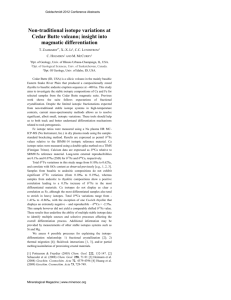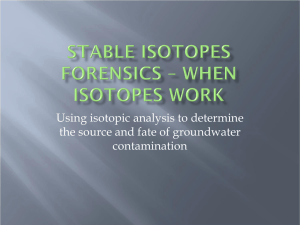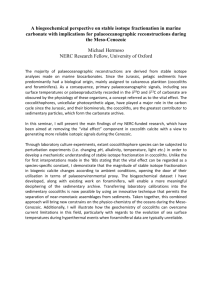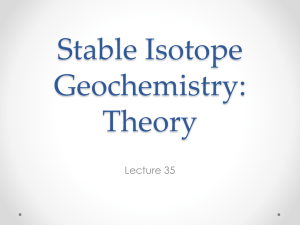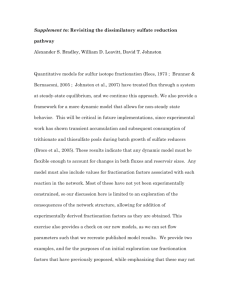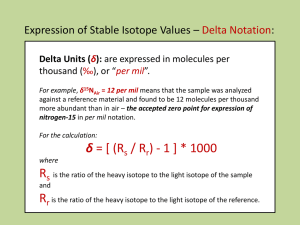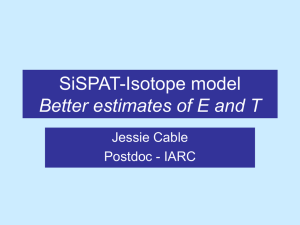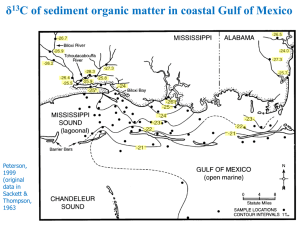Experimental Study of the copper isotope fractionation between
advertisement
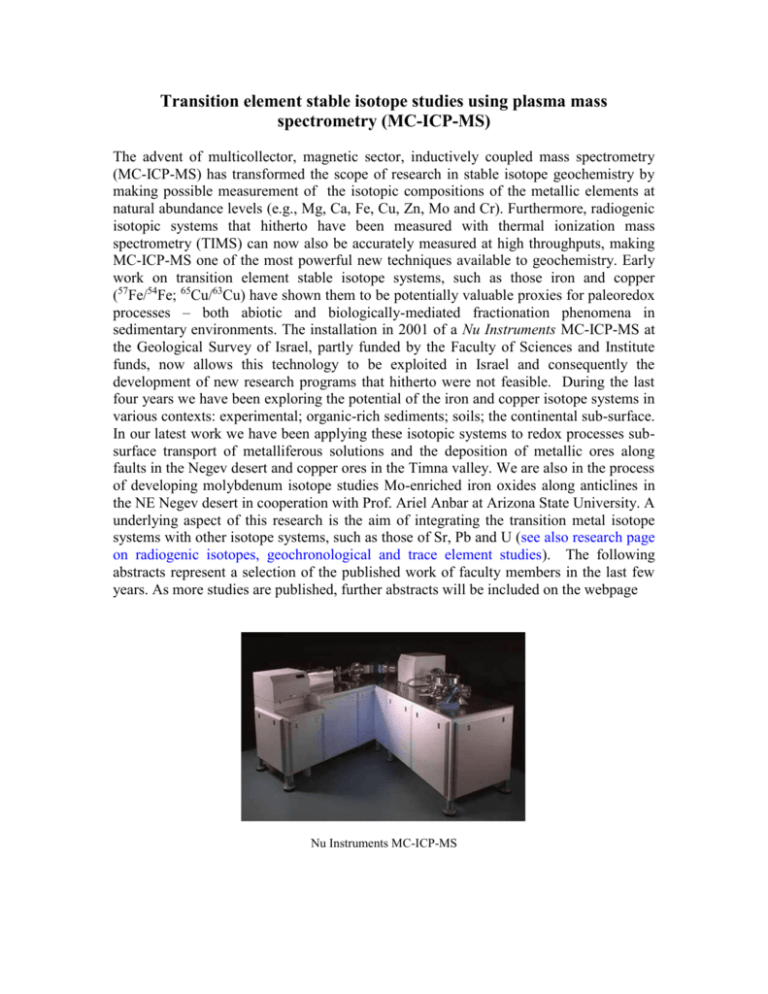
Transition element stable isotope studies using plasma mass spectrometry (MC-ICP-MS) The advent of multicollector, magnetic sector, inductively coupled mass spectrometry (MC-ICP-MS) has transformed the scope of research in stable isotope geochemistry by making possible measurement of the isotopic compositions of the metallic elements at natural abundance levels (e.g., Mg, Ca, Fe, Cu, Zn, Mo and Cr). Furthermore, radiogenic isotopic systems that hitherto have been measured with thermal ionization mass spectrometry (TIMS) can now also be accurately measured at high throughputs, making MC-ICP-MS one of the most powerful new techniques available to geochemistry. Early work on transition element stable isotope systems, such as those iron and copper (57Fe/54Fe; 65Cu/63Cu) have shown them to be potentially valuable proxies for paleoredox processes – both abiotic and biologically-mediated fractionation phenomena in sedimentary environments. The installation in 2001 of a Nu Instruments MC-ICP-MS at the Geological Survey of Israel, partly funded by the Faculty of Sciences and Institute funds, now allows this technology to be exploited in Israel and consequently the development of new research programs that hitherto were not feasible. During the last four years we have been exploring the potential of the iron and copper isotope systems in various contexts: experimental; organic-rich sediments; soils; the continental sub-surface. In our latest work we have been applying these isotopic systems to redox processes subsurface transport of metalliferous solutions and the deposition of metallic ores along faults in the Negev desert and copper ores in the Timna valley. We are also in the process of developing molybdenum isotope studies Mo-enriched iron oxides along anticlines in the NE Negev desert in cooperation with Prof. Ariel Anbar at Arizona State University. A underlying aspect of this research is the aim of integrating the transition metal isotope systems with other isotope systems, such as those of Sr, Pb and U (see also research page on radiogenic isotopes, geochronological and trace element studies). The following abstracts represent a selection of the published work of faculty members in the last few years. As more studies are published, further abstracts will be included on the webpage Nu Instruments MC-ICP-MS 1. Mass Fractionation Processes of Transition Metal Isotopes. Earth Planet. Sci. Lett. 200: 47-62 (2002). X. K. Zhu1)*, Y. Guo1), R. K. O’Nions1), R. J. P. Williams2), A. Matthews1, 3), N. S. Belshaw1), G. W. Canters4), E. C. de Waal4), U. Weser5), B. K. Burgess6), B. Salvato7) 1 Department of Earth Sciences, University of Oxford2 Department of Chemistry, University of Oxford,3 Institute of Earth Sciences, Hebrew University of Jerusalem, 4 Department of Chemistry, Leiden University, 5 Physiologisch-Chemische Institut, Eberhard-Karls-Universität Tübingen, 6 Department of Molecular Biology and Biochemistry, University of California, Irvine,7 CNR Centre of Metalloproteins, Padua University. Abstract – Recent advances in mass spectrometry make it possible to utilize isotope variations of transition metals to address some important issues in solar system and biological Sciences. Realization of the potential offered by these isotope systems however requires an adequate understanding of the factors controlling their isotope fractionations. Here we show the results of a broadly based study on copper and iron isotope fractionation during various inorganic and biological processes. These results demonstrate that: (1) naturally occurring inorganic processes can fractionate Fe isotopes to a detectable level even at temperature ~ 1000ºC, which challenges the previous view that Fe isotope variations in natural systems are unique biosignatures; (2) multiple-step equilibrium processes at low temperatures may cause large mass fractionation of transition metal isotopes even when the fractionation per single step is small; (3) oxidationreduction is an important controlling factor of isotope fractionation of transition metal elements with multiple valences (See figure showing copper isotope results in epsilon units and a Rayleigh model simulating the isotopic composition of Cu(I) iodide (curve C) and Cu(II)solution (Curve A)), which opens up a wide range of applications of these new isotope systems, ranging from metal-silicate fractionation in the solar system to uptake pathways of these elements in biological systems; (4) organisms incorporate lighter isotopes of transition metals preferentially, and transition metal isotope fractionation occurs stepwise along their pathways within biological systems during their uptake. 2. Controls on iron-isotope fractionation in organic-rich sediments (Kimmeridge Clay, Upper Jurassic, southern England). Geochim. Cosmochim. Acta 68: 3107-3123 (2004) Alan Matthews1, Helen S. Morgans-Bell2, Simon Emmanuel1*,Hugh C. Jenkyns2, Yigal Erel1 and Ludwik Halicz3 1 Institute of Earth Sciences, Hebrew University of Jerusalem,2 Department of Earth Sciences, University of Oxford, 3 Geological Survey of Israel. depth (m) Abstract– This study explores the fractionation of iron isotopes ( 57Fe/54Fe) in an organic-rich mudstone succession, focusing on core and outcrop material sampled from the Upper Jurassic Kimmeridge Clay Formation type locality in south Dorset, UK. The organic-rich environments recorded by the succession provide an excellent setting for an investigation of the mechanisms by which iron isotopes are partitioned among mineral phases during biogeochemical sedimentary processes. Two main types of iron-bearing assemblage are defined in the core material: mudstones with calcite ±pyrite ± siderite mineralogy, and ferroan dolomite (dolostone) bands. A cyclic data distribution is apparent, which reflects variations in isotopic composition from a lower range of 57Fe values associated with the pyrite/siderite mudstone samples to the generally higher values of the adjacent dolostone samples (see figure on this page illustrating the iron isotope compositions). Most pyrite/siderite mudstones vary between -0.4 and 0.1 ‰ while dolostones range between -0.1 and 0.5 ‰, although in very organic-rich shale samples below 360 m core depth higher 57Fe values are noted. Pyrite nodules and pyritized ammonites from the type exposure yield 57Fe values of -0.3 to -0.45 ‰. A fractionation model consistent with the 57Fe variations relates the lower 57Fe pyrite and siderite ± pyrite mudstones values to the production of isotopically depleted Fe(II) during biogenic reduction of the isotopically heavier lithogenic Fe(III) oxides. A consequence of this reductive dissolution is that a 57Fe-enriched iron species must be produced that potentially becomes available Stone Bands for the formation of the higher 57Fe dolostones. An Siderite-Pyrite-calcite-bearing mudstones isotopic profile across a dolostone band reveals Pyrite-Calcite-bearing mudstones distinct zonal variations in 57Fe, characterized by -80 Lithogenic Fe oxides (this study) 4 1, 2 3 5 two peaks, respectively located above and below the 120 central part of the band, and decoupling of the Lithogenic Fe (III) Range isotopic composition from the iron content. This (Beard et al, 2003b) 160 form of isotopic zoning is shown to be consistent with a one-dimensional model of diffusional200 chromatographic Fe-isotope exchange between dolomite and isotopically enriched pore water. An 240 alternative mechanism envisages the infiltration of 280 dissolved ferrous iron from variable (high and low) 57Fe sources during co-precipitation of Fe(II) ion 320 with dolomite. The study provides clear evidence that iron isotopes are cycled during the formation and 360 ±1 diagenesis of organic carbon-rich sediments. 400 -0.5 0 0.5 57 Fe (IRMM-Fe) ‰ 1 3. Experimental Study of the copper isotope fractionation between aqueous Cu(II) and covellite, CuS. Chemical Geology 209: 259-269 (2004) S. Ehrlicha, I. Butlerb, L. Halicza, D. Rickardb A. Oldroydb, Alan Matthewsc a Geological Survey of Israel b School of Earth, Ocean and Planetary Sciences, Cardiff University c Institute of Earth Sciences, Hebrew University of Jerusalem. Abstract – We report the results of a study of the geologically important copper isotope (65Cu/63Cu) fractionation between aqueous Cu(II) and copper sulphide. The experiments were made in anoxic conditions by precipitating covellite (CuS) from excess Cu as aqueous CuSO4 through the addition of aqueous Na2S. Isotopic measurements were collected on a Nu Instruments MC-ICP-MS using sample-standard bracketing and mass-bias correction using a nickel internal standard. The results of a series of experiments at 20°C give a mean fractionation of 65Cu (Cu(II)aq –CuS) = 3.06 ± 0.14 ‰. Additional experiments made at 2°, 10° and 40°C show that the fractionation factor varies inversely with temperature according to the relation (errors at 1 level): Cu(II) – CuS = 0.26 ± 0.02 x 106T-2 + 0.08 ± 0.25. Although the question of whether complete equilibration occurs during the precipitation reaction cannot be resolved, the measured fractionation factors provide a proxy for the natural fractionation processes involving abiogenic covellite formation by low-temperature precipitation. The ~ 3‰ Cu(II)aq–CuS fractionation compares with small experimentally measured Cu(II)aq-malachite fractionation (0.20 to 0.38 ± 0.04 ‰ at 30°C) reported by Maréchal and Sheppard (2002) and a similar fractionation measured in this study for Cu(II) hydroxide precipitation from Cu(II)aq solution. The large Cu(II)aq –CuS isotopic fractionation supports the conclusion that covellite is a Cu(I)S(-I) compound and that redox state is potentially a significant control of abiogenic 65 Cu/63Cu fractionations in low-temperature geological environments. 4. A preliminary mixing model for Fe isotopes in soils. Chemical Geology 222: 23-34 (2005) S. Emmanuela, Y. Erela, A. Matthewsa, N. Teutschb a Institute of Earth Sciences, Hebrew University b Swiss Federal Institute for Aquatic Science and Technology. Abstract - Iron partitioning data and whole soil 57Fe values were combined to calculate the isotopic composition of Fe mixing end-members in these soils. A least squares method was used to estimate the iron isotope composition of the end-members representing the three main Fe reservoirs in the Czech soil: (1) silicates (57Fe = -0.02 ± 0.17 ‰), (2) organically bound iron (57Fe = -0.48 ± 0.27 ‰), and (3) pedogenic Fe oxides (57Fe = -1.07 ± 1.02 ‰). A lack of variation in the isotopic and chemical partitioning patterns in the Israeli soil prevented the application of the least squares technique, although an Fe-oxide end member is also proposed using a similar mixing model (57Fe = -1.72 ± 1.16 ‰). Combination of the isotopic values for the reservoirs found this study with published isotopic fractionation data suggests that the silicate fraction in the Israeli soil is dominated by lithogenic sources, whereas the Fe-oxide pool is mainly influenced by pedogenic precipitation-dissolution processes. The results demonstrate the potential for Fe isotopes as a tool to quantify Fe cycling in soils
